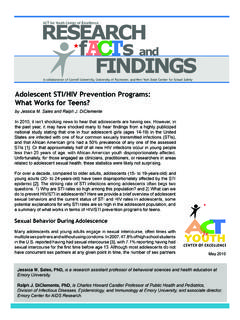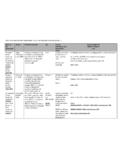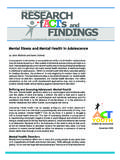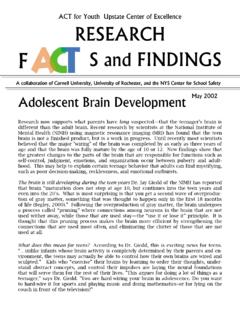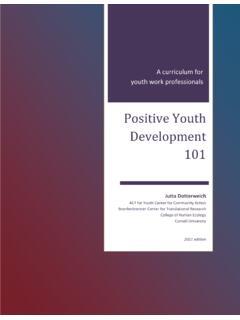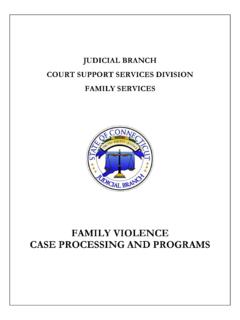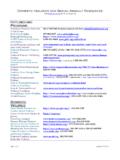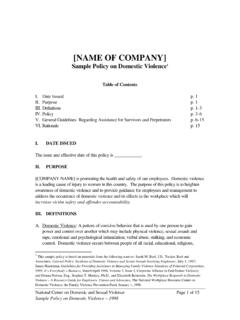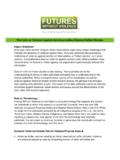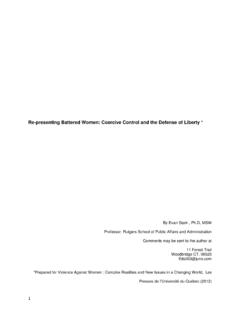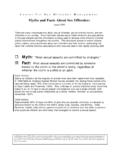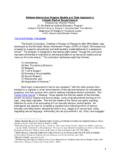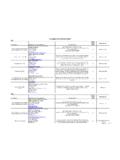Transcription of February 2006 Teen Dating Violence - ACT for Youth
1 Teen Dating Violenceby Jane Powers and Erica KermanFebruary 2006 Continued on page 2 Over the last several decades, Dating Violence hasemerged as a significant public health issue. However,until recently most Dating Violence research has focusedon adult couples or college students, not on suggests that Dating Violence among highschool students is more widespread than previouslybelieved, and may have serious developmentalconsequences. Adolescents are especially vulnerable tothis form of Violence since it may interfere with two tasksthat are integral to healthy social development: 1)establishing caring, meaningful relationships, and 2)developing interpersonal intimacy.
2 Adolescents may beat even greater risk than adults for physical andpsychological harm given their lack of experience, desirefor independence, and reliance on support frominexperienced peers (Callahan, 2003). These factors limittheir ability to respond to Violence and access effectiveintervention. Additionally, individuals who experiencedating Violence during adolescence may be at increasedrisk for continued interpersonal Violence in adulthood bothas victims and/or of the ProblemAlthough once narrowly conceptualized as involving onlyphysical force, Dating Violence is now more broadlyrecognized as a continuum of abuse which can range fromincidents of emotional and verbal abuse to rape andmurder (Hickman et al, 2004).
3 It involves a pattern ofcoercive, manipulative behavior that one partner exertsover the other for the purpose of establishing andmaintaining power and control. Efforts to measure theextent of Dating Violence suggest that as many as one inthree teens may experience this a national sample, the Centers for Disease Control(2000) reported that the average prevalence of datingviolence for high school and college students is 22% and32% respectively. Recently, Silverman et al (2002)analyzed 1997 and 1998 data from the MassachusettsYouth Risk Behavior Survey and estimated that one infive adolescent high school girls experienced datingviolence.
4 Using data from the National Longitudinal StudyNational Teen Dating Violence Awareness andPrevention Week is February more information and a free tool kit, recognizing the impact of teen Dating Violence in theirlives, teens throughout New York State designed postersand artwork as entries for the 2005 Teen Dating ViolenceMedia Contest. For more information: Adolescent Health collected during the 1994-95school year, Halpern et al (2001) found that 32% ofadolescents in 7-12th grade reported experiencing somekind of Violence in Dating relationships within the 18months prior to the interview.
5 Other smaller scale studieshave found prevalence rates of Dating Violence rangingfrom 9% to 57% (O Keefe, 2005).Reasons why prevalence rates vary so significantly haveto do with the lack of standardized definitions used toassess Dating Violence . Some researchers includepsychological and emotional abuse in their definitionwhile others are more restrictive and only includephysically violent acts. Furthermore, sexual Violence isoften excluded from definitions. Some studies onlyrecord Violence that has occurred in a single or recentrelationship while others consider Violence occurring inmultiple relationships across longer periods of time.
6 Inaddition, the reliability of these data is questionable sincemost Dating Violence research relies on self-reportmeasures which are subject to socially Role of GenderStudies demonstrate that non-sexual Violence in datingrelationships frequently involves the reciprocal use ofviolence by both males and females. In fact, a consistentbut counterintuitive finding is that female adolescentsinflict more physical Violence than male adolescents, withfemale perpetration rates ranging from 28% to 33% incontrast to male perpetration rates ranging from 11%to 20% (Foshee, 1996; Malik et al, 1997; O Keefe,1997).
7 Although this finding supports the general trendof increased aggression among adolescent girls ( ,Cummings et al., 2000), the context of the violentincident must be taken into account: girls often inflictharm on others in self defense. Reporting biases alsocome into play. Whereas males may tend to underreport,deny or minimize their own aggression, females may overreport to accept blame and take greater responsibilityfor initiating Violence (Jackson, 1999; Le Jeune andFollette 1994). When sexual Violence is examined,however, dramatic gender differences emerge withfemales sustaining significantly more sexual victimizationthan males (Foshee, 1996; Molidor et al, 2000).
8 Gender also appears to influence the reasons whyteenagers engage in Dating Violence . Although anger isthe most frequently cited motive for both male and femaleadolescents, females more often cite self defense whilemales cite the desire to control one s partner (Foshee,1996; O Keefe, 1997; Watson, 2001). Gender also mayinfluence the impact of Dating Violence . Given their oftengreater size and strength, adolescent males are more likelyto exert greater harm on their female victims. Comparedto boys, girls are more likely to sustain injuries and requiremedical treatment as a result of Dating Violence (Makepeace, 1987).
9 Furthermore, males and females mayperceive their victimization differently: females indicatesignificantly more emotional hurt and fear (Foshee, 1996;O Keefe and Treister, 1998). For example, Molidor et al(2000) found the majority of adolescent boys in theirsample (56%) were not hurt at all by the worst reportedincident of Dating Violence , however, only 9% of girls3 Photos courtesy of the New York State Center forSchool Safety and their Please Stand Up! at being unhurt while nearly half (48%) reportedbeing hurt a lot. Risk Factors for Dating Violence Perpetrationand VictimizationStudies suggest that certain early childhood experiencesmay predispose individuals to violent tendencies in theirromantic relationships as adolescents and who experienced greater family instability,maltreatment, or social disadvantage tend to date at ayounger age and experience Dating Violence at higher thanaverage rates.
10 Among a sample of 14-16-year old girlsreceiving child protection services, 90% had begun datingand over 50% experienced sexual and physical violencein a romantic relationship (Wekerle & Wolfe, 1999).Young people who witness domestic Violence in theirfamily of origin are at a higher risk of inflicting violenceupon later romantic partners, although these findings havebeen somewhat inconsistent. This association appearsto be stronger for males than for females. The witnessingof inter-parental Violence plays a less significant role inbecoming a victim of Dating Violence for both genders(O Keefe, 2005).
